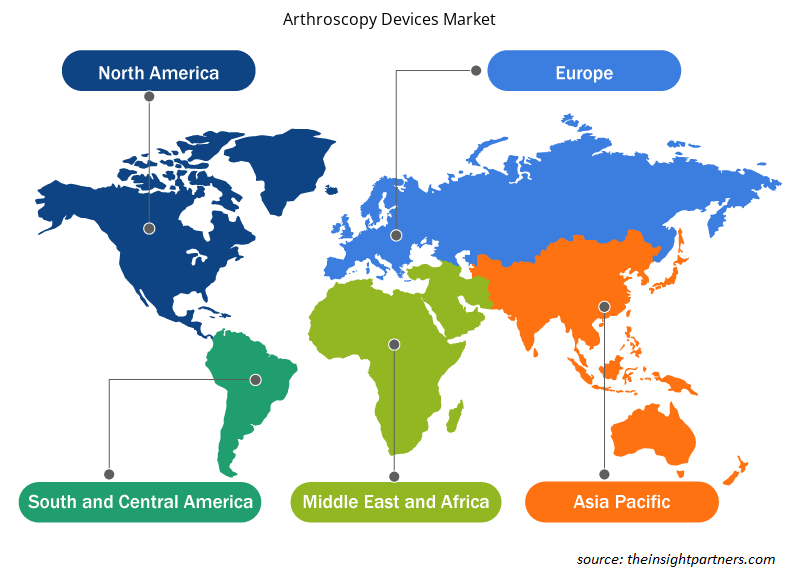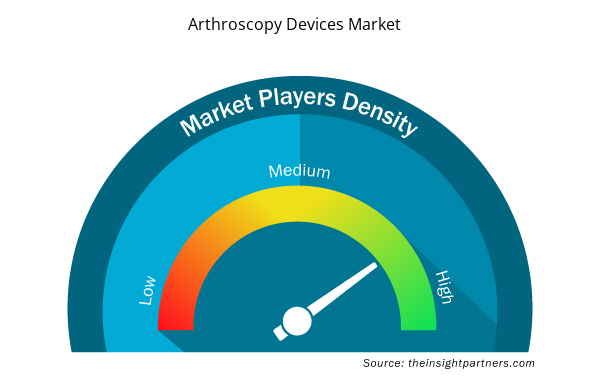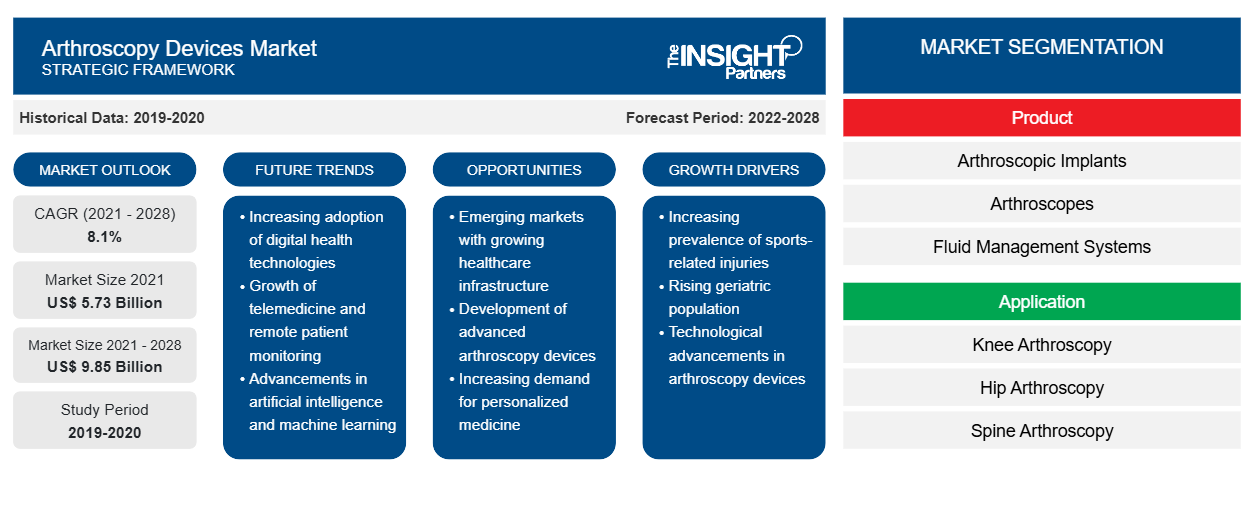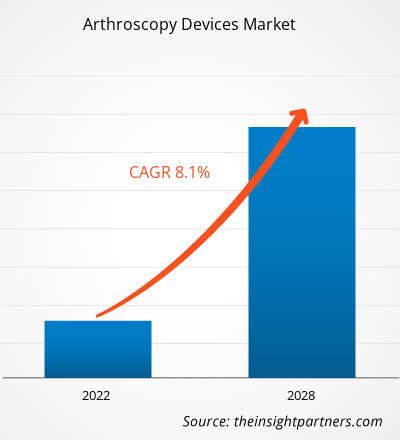Si prevede che il mercato dei dispositivi per artroscopia raggiungerà i 9.853,88 milioni di dollari entro il 2028, rispetto ai 5.725,24 milioni di dollari del 2021; si prevede che registrerà un CAGR dell'8,1% dal 2021 al 2028.
L'artroscopia è una procedura per la diagnosi e il trattamento di problemi articolari. Un chirurgo inserisce un tubo stretto collegato a una telecamera video a fibre ottiche chiamata artroscopio attraverso una piccola incisione delle dimensioni di un'asola. Un artroscopio è un dispositivo medico che consente ai medici di vedere all'interno delle articolazioni del corpo come ginocchio, anca, colonna vertebrale, spalla e gomito per ispezionare, diagnosticare ed eseguire procedure terapeutiche. I dispositivi di artroscopia possono esaminare malattie come osteoartrite, artrite reumatoide, tendinite e tumori ossei nelle articolazioni.
Il rapporto offre approfondimenti e analisi approfondite del mercato dei dispositivi per artroscopia, sottolineando vari parametri come tendenze di mercato, progressi tecnologici e dinamiche di mercato. Fornisce inoltre l'analisi del panorama competitivo dei principali attori del mercato in tutto il mondo. Inoltre, include l'impatto della pandemia di COVID-19 sul mercato in tutte le regioni. La pandemia di COVID-19 ha creato sia una crisi di salute pubblica che una crisi economica in tutto il mondo. Prima della pandemia, il mercato globale dei dispositivi per artroscopia era in costante crescita poiché erano in corso screening, consolazioni e trattamenti regolari. La prima ondata di COVID-19 ha interrotto le consultazioni, i follow-up e gli screening dei casi oncologici. La situazione incontrollata creata nel settore sanitario in tutto il mondo ha portato alla riduzione del numero di consultazioni e a un numero inferiore di casi di osteoartrite e artrite reumatoide diagnosticati. Diverse aziende hanno subito gravi perdite nell'ultimo trimestre del 2019; la pandemia ha influenzato negativamente anche il primo e il secondo trimestre del 2020. Quindi, l'impatto della pandemia di COVID-19 sul mercato globale è stato immediato e drastico. Le aziende in tutto il mondo sono state ostacolate a causa dell'interruzione della catena di fornitura e dell'aumento della domanda di prodotti e servizi sanitari. Per ridurre l'infezione da COVID-19 negli ospedali e nelle cliniche, gli operatori sanitari e i pazienti hanno adottato e preferito il trattamento dei pazienti a distanza. In queste circostanze imprevedibili, la pratica ortopedica non poteva rimanere inalterata. Molti trattamenti chirurgici e visite non urgenti sono stati annullati o posticipati. La chirurgia elettiva è stata sospesa in molte istituzioni e il volume complessivo dei casi ortopedici è diminuito drasticamente per limitare la diffusione del virus e riservare e riallocare le risorse nel personale sanitario (infermieri, anestesisti), nelle attrezzature mediche (dispositivi di protezione individuale, ventilatori) e nei letti. La strategia "resta a casa" nel mondo ha portato a una significativa riduzione degli interventi di artroplastica e artroscopia, nonché a una diminuzione dell'incidenza dei casi di osteoartrite durante il periodo del COVID-19.
Personalizza questo report in base alle tue esigenze
Riceverai la personalizzazione gratuita di qualsiasi report, comprese parti di questo report, o analisi a livello nazionale, pacchetto dati Excel, oltre a usufruire di grandi offerte e sconti per start-up e università
- Scopri le principali tendenze di mercato in questo rapporto.Questo campione GRATUITO includerà analisi di dati che spaziano dalle tendenze di mercato alle stime e alle previsioni.
Poiché l'infrastruttura sanitaria è stata interrotta a causa dell'epidemia di COVID-19 e l'attenzione è stata spostata sul trattamento del COVID-19, la diagnosi di varie malattie è stata trascurata. Inoltre, anche l'individuazione e il trattamento delle malattie muscoloscheletriche sono stati ostacolati dalla pandemia di COVID-19. Ciò ha notevolmente frenato la crescita del mercato dei dispositivi per artroscopia in tutto il mondo.
Approfondimenti di mercato
La crescente prevalenza di disturbi muscoloscheletrici guiderà il mercato
I disturbi muscoloscheletrici (DMS) sono le condizioni di salute più comuni al mondo. Secondo i dati pubblicati dall'Organizzazione Mondiale della Sanità (OMS), a febbraio 2021, circa 1,71 miliardi di individui in tutto il mondo soffrivano di problemi muscoloscheletrici. Il dolore lombare è una condizione muscoloscheletrica diffusa, che colpisce 568 milioni di persone in tutto il mondo. Il dolore lombare è la principale causa di disabilità in 160 paesi. I disturbi muscoloscheletrici compromettono gravemente la mobilità e la destrezza, con conseguente pensionamento anticipato dal lavoro, diminuzione del benessere e ridotta capacità di socializzare. Il numero di persone disabili a causa di condizioni muscoloscheletriche è in crescita e si prevede che questa tendenza continuerà nei prossimi decenni.MSDs) are the most common health conditions worldwide. According to the data published by the World Health Organization (WHO), in February 2021, approximately 1.71 billion individuals worldwide suffered from musculoskeletal problems. Lower back pain is a widespread musculoskeletal condition, affecting 568 million people worldwide. Lower back pain is the major cause of impairment in 160 countries. Musculoskeletal disorders severely impair mobility and dexterity, resulting in early retirement from work, decreased well-being, and diminished ability to socialize. The number of people disabled by musculoskeletal conditions has been growing, and this trend is expected to continue in the next decades.
Inoltre, secondo l'OMS, i paesi ad alto reddito sono i più colpiti in termini di popolazione (441 milioni), seguiti dai paesi della regione del Pacifico occidentale dell'OMS con 427 milioni, mentre il Sud-est asiatico ne ha 369 milioni. Le malattie muscoloscheletriche sono anche la causa principale di anni vissuti con disabilità (YLD) in tutto il mondo, rappresentando circa 149 milioni di YLD, ovvero il 17% di tutti gli YLD. Le fratture, che colpiscono 436 milioni di persone in tutto il mondo, l'osteoartrite (343 milioni), altre lesioni (305 milioni), i dolori al collo (222 milioni), le amputazioni (175 milioni) e l'artrite reumatoide (14 milioni) contribuiscono tutte al peso complessivo delle malattie muscoloscheletriche.YLDs) worldwide, accounting for roughly 149 million YLDs, or 17% of all YLDs. Fractures, which affect 436 million people worldwide, osteoarthritis (343 million), other injuries (305 million), neck pains (222 million), amputations (175 million), and rheumatoid arthritis (14 million) all contribute to the overall burden of musculoskeletal diseases.
L'artroscopia chirurgica è un'opzione terapeutica consolidata per gli individui con dolore e disfunzione articolare cronici. Rispetto alle procedure articolari aperte, l'artroscopia è meno invasiva e comporta migliori risultati complessivi per i pazienti nel trattamento dei sintomi, degenza ospedaliera, recupero strutturale e risultati a lungo termine. Pertanto, si prevede che la crescente prevalenza di disturbi muscoloscheletrici, osteoartrite e artrite reumatoide guiderà il mercato durante il periodo di previsione.
Approfondimenti basati sui prodotti
In base al prodotto, il mercato dei dispositivi per artroscopia è segmentato in artroscopi, impianti artroscopici, sistemi di gestione dei fluidi , sistemi a radiofrequenza, sistemi di visualizzazione, sistemi di rasoio motorizzati e altre apparecchiature artroscopiche. Nel 2021, il segmento degli artroscopi ha detenuto la quota maggiore del mercato e si prevede che registrerà il CAGR più rapido del 9,1% durante il periodo di previsione. radiofrequency systems, visualization systems, powered shaver systems, and other arthroscopic equipment. In 2021, the arthroscopes segment held the largest share of the market and is expected to register the fastest CAGR of 9.1% during the forecast period.
Approfondimenti basati sulle applicazioni
In base all'applicazione, il mercato dei dispositivi per artroscopia è segmentato in artroscopia del ginocchio, artroscopia dell'anca, artroscopia della colonna vertebrale, artroscopia del piede e della caviglia, artroscopia della spalla e del gomito e altri. Nel 2021, il segmento dell'artroscopia dell'anca ha detenuto la quota maggiore del mercato e si prevede che registrerà il CAGR più elevato dell'8,9% nel periodo 2021-2028.CAGR of 8.9% during 2021–2028.
Gli operatori del mercato dei dispositivi per artroscopia adottano strategie organiche, come il lancio e l'espansione dei prodotti, per espandere la propria presenza e il portafoglio prodotti in tutto il mondo e soddisfare la crescente domanda.
Per Geografia
In base all'area geografica, il mercato dei dispositivi per artroscopia è segmentato in Nord America (Stati Uniti, Canada e Messico), Europa (Regno Unito, Germania, Francia, Italia, Spagna e resto d'Europa), Asia Pacifico (Cina, Giappone, India, Australia, Corea del Sud e resto dell'Asia Pacifico), Medio Oriente e Africa (Emirati Arabi Uniti, Arabia Saudita, Sudafrica e resto del Medio Oriente e dell'Africa) e Sud e Centro America (Brasile, Argentina e resto del Sud e Centro America).UAE, Saudi Arabia, South Africa, and the Rest of Middle East & Africa), and South & Central America (Brazil, Argentina, and the Rest of South & Central America).
Approfondimenti regionali sul mercato dei dispositivi per artroscopia
Le tendenze regionali e i fattori che influenzano il mercato dei dispositivi per artroscopia durante il periodo di previsione sono stati ampiamente spiegati dagli analisti di Insight Partners. Questa sezione discute anche i segmenti e la geografia del mercato dei dispositivi per artroscopia in Nord America, Europa, Asia Pacifico, Medio Oriente e Africa e Sud e Centro America.

- Ottieni i dati specifici regionali per il mercato dei dispositivi di artroscopia
Ambito del rapporto di mercato sui dispositivi di artroscopia
| Attributo del report | Dettagli |
|---|---|
| Dimensioni del mercato nel 2021 | 5,73 miliardi di dollari USA |
| Dimensioni del mercato entro il 2028 | 9,85 miliardi di dollari USA |
| CAGR globale (2021 - 2028) | 8,1% |
| Dati storici | 2019-2020 |
| Periodo di previsione | 2022-2028 |
| Segmenti coperti | Per Prodotto
|
| Regioni e Paesi coperti | America del Nord
|
| Leader di mercato e profili aziendali chiave |
|
Densità degli attori del mercato dei dispositivi di artroscopia: comprendere il suo impatto sulle dinamiche aziendali
Il mercato dei dispositivi per artroscopia sta crescendo rapidamente, spinto dalla crescente domanda degli utenti finali dovuta a fattori quali l'evoluzione delle preferenze dei consumatori, i progressi tecnologici e una maggiore consapevolezza dei vantaggi del prodotto. Con l'aumento della domanda, le aziende stanno ampliando le loro offerte, innovando per soddisfare le esigenze dei consumatori e capitalizzando sulle tendenze emergenti, il che alimenta ulteriormente la crescita del mercato.
La densità degli operatori di mercato si riferisce alla distribuzione di aziende o società che operano in un particolare mercato o settore. Indica quanti concorrenti (operatori di mercato) sono presenti in un dato spazio di mercato in relazione alle sue dimensioni o al valore di mercato totale.
Le principali aziende che operano nel mercato dei dispositivi per artroscopia sono:
- Azienda
- Società CONMED
- Johnson and Johnson Services, Inc.
- KARL STORZ SE & Co. KG
- Medtronic
Disclaimer : le aziende elencate sopra non sono classificate secondo un ordine particolare.

- Ottieni una panoramica dei principali attori del mercato dei dispositivi per artroscopia
Profili aziendali
- Azienda
- Società CONMED
- Johnson and Johnson Services, Inc.
- KARL STORZ SE & Co. KG
- Medtronic
- Azienda: Richard Wolf GmbH.
- Fabbro e nipote
- Società per azioni Stryker
- Zimmer Biomet
- NuVasive, Inc.
- Analisi storica (2 anni), anno base, previsione (7 anni) con CAGR
- Analisi PEST e SWOT
- Valore/volume delle dimensioni del mercato - Globale, regionale, nazionale
- Industria e panorama competitivo
- Set di dati Excel



Report Coverage
Revenue forecast, Company Analysis, Industry landscape, Growth factors, and Trends

Segment Covered
This text is related
to segments covered.

Regional Scope
North America, Europe, Asia Pacific, Middle East & Africa, South & Central America

Country Scope
This text is related
to country scope.
Domande frequenti
The North America region secures the major share of the global arthroscopy devices market. Rapid increase in the number of arthroscopies in the region, advancements in arthroscopy products and the highly active research ecosystem for arthroscopic applications is projected to accelerate the growth of the market. Moreover, increasing prevalence of chronic diseases and orthopedic ailments, especially among the aging population in this region of arthroscopy devices is propelling the market's expansion in this region.
Due to an increasing number of infected patients worldwide, several research institutes and leading organizations put an effort to develop efficient methods of COVID 19 treatment and ways to combat pandemic. Many companies manufacturing arthroscopy devices focused on responding emergencies by various strategies such as manufacturing PPEs to healthcare workers, distribution of pharmaceutical drugs and various other activities. For instance, in September 2020, Arthrex, a global leader in minimally invasive orthopedic technology, announced it is using its innovative production capabilities to manufacture and donate more than 6,000 protective face shields to school systems across the region.
According to World Health Organization (WHO). As the epidemic has become a global pandemic, many health authorities focused pandemic-related care and avoided human contact in reaction to growing transmission and strain on health-care resources by postponing elective surgeries, suspending outpatient clinics, and triaging employees involved in urgent care. For instance, as per the British Journal of Surgery published in May 2020 stated that orthopedic procedures would be affected most, with 6.3 million operations cancelled worldwide. Recent COVID-19 guidelines for pediatric orthopedic surgeons suggested focus on urgent care and triaging cases to postpone elective surgeries and clinic appointments, with transition to virtual-based care when appropriate.
Thus, the pandemic had a negative impact on the arthroscopy market in the region.
Johnson and Johnson Services, Inc and CONMED Corporation are the top two companies that hold huge market shares in the arthroscopy devices market.
The arthroscopy devices market majorly consists of players such as Arthrex, Inc.; CONMED Corporation; Johnson and Johnson Services, Inc.; KARL STORZ SE & Co. KG; Medtronic; Richard Wolf GmbH.; Smith & Nephew; Stryker Corporation; Zimmer Biomet; and NuVasive, Inc amongst others.
In 2021, the hip arthroscopy held the largest share of the market, by application. The similar application segment of the arthroscopy devices market is expected to witness growth in its demand at the fastest CAGR from 2021 to 2028.
Arthroscopy is a procedure for diagnosing and treating joint problems. A surgeon inserts a narrow tube attached to a fiber-optic video camera through a small incision about the size of a buttonhole which is called an arthroscope. An arthroscope is a medical device that allows doctors to see within bodily joints such as the knee, hip, spine, shoulder, and elbow to inspect, diagnose, and perform therapeutic procedures. Arthroscopy devices can examine for illnesses like osteoarthritis, rheumatoid arthritis, tendinitis, and bone tumors in the joints.
Key factors that are driving the growth of this market are the growing prevalence of musculoskeletal disorders osteoarthritis and rheumatoid arthritis, rising number of sport injuries requiring arthroscopy procedure to prevent complete joint and rising elderly population. Additionally, the increasing prevalence of obesity and rising number of product launches and approvals are likely to emerge as a significant future trend in the market during the forecast period.
The CAGR value of the arthroscopy devices market during the forecasted period of 2021–2028 is 8.1%.
In 2021, the arthroscopes segment accounted for the largest share of the market; it is further expected to continue its dominance over the forecast period. The arthroscopes are primarily used in the minimally invasive strategy. It aids patients' recovery and reduces scarring. Moreover, the decrease in the life span of arthroscopes due to the sterilization process used to prevent contamination and the launch of single-use arthroscopes. Thus, due to above factors, the arthroscopes segment is expected to dominate the arthroscopy devices market by product segment. Moreover, arthroscopes are expected to register the highest CAGR in arthroscopy devices market during 2021-2028.
Trends and growth analysis reports related to Life Sciences : READ MORE..
The List of Companies - Arthroscopy Devices Market
- Arthrex, Inc.
- CONMED Corporation
- Johnson and Johnson Services, Inc.
- KARL STORZ SE & Co. KG
- Medtronic
- Richard Wolf GmbH.
- Smith & Nephew
- Stryker Corporation
- Zimmer Biomet
- NuVasive, Inc.
The Insight Partners performs research in 4 major stages: Data Collection & Secondary Research, Primary Research, Data Analysis and Data Triangulation & Final Review.
- Data Collection and Secondary Research:
As a market research and consulting firm operating from a decade, we have published and advised several client across the globe. First step for any study will start with an assessment of currently available data and insights from existing reports. Further, historical and current market information is collected from Investor Presentations, Annual Reports, SEC Filings, etc., and other information related to company’s performance and market positioning are gathered from Paid Databases (Factiva, Hoovers, and Reuters) and various other publications available in public domain.
Several associations trade associates, technical forums, institutes, societies and organization are accessed to gain technical as well as market related insights through their publications such as research papers, blogs and press releases related to the studies are referred to get cues about the market. Further, white papers, journals, magazines, and other news articles published in last 3 years are scrutinized and analyzed to understand the current market trends.
- Primary Research:
The primarily interview analysis comprise of data obtained from industry participants interview and answers to survey questions gathered by in-house primary team.
For primary research, interviews are conducted with industry experts/CEOs/Marketing Managers/VPs/Subject Matter Experts from both demand and supply side to get a 360-degree view of the market. The primary team conducts several interviews based on the complexity of the markets to understand the various market trends and dynamics which makes research more credible and precise.
A typical research interview fulfils the following functions:
- Provides first-hand information on the market size, market trends, growth trends, competitive landscape, and outlook
- Validates and strengthens in-house secondary research findings
- Develops the analysis team’s expertise and market understanding
Primary research involves email interactions and telephone interviews for each market, category, segment, and sub-segment across geographies. The participants who typically take part in such a process include, but are not limited to:
- Industry participants: VPs, business development managers, market intelligence managers and national sales managers
- Outside experts: Valuation experts, research analysts and key opinion leaders specializing in the electronics and semiconductor industry.
Below is the breakup of our primary respondents by company, designation, and region:

Once we receive the confirmation from primary research sources or primary respondents, we finalize the base year market estimation and forecast the data as per the macroeconomic and microeconomic factors assessed during data collection.
- Data Analysis:
Once data is validated through both secondary as well as primary respondents, we finalize the market estimations by hypothesis formulation and factor analysis at regional and country level.
- Macro-Economic Factor Analysis:
We analyse macroeconomic indicators such the gross domestic product (GDP), increase in the demand for goods and services across industries, technological advancement, regional economic growth, governmental policies, the influence of COVID-19, PEST analysis, and other aspects. This analysis aids in setting benchmarks for various nations/regions and approximating market splits. Additionally, the general trend of the aforementioned components aid in determining the market's development possibilities.
- Country Level Data:
Various factors that are especially aligned to the country are taken into account to determine the market size for a certain area and country, including the presence of vendors, such as headquarters and offices, the country's GDP, demand patterns, and industry growth. To comprehend the market dynamics for the nation, a number of growth variables, inhibitors, application areas, and current market trends are researched. The aforementioned elements aid in determining the country's overall market's growth potential.
- Company Profile:
The “Table of Contents” is formulated by listing and analyzing more than 25 - 30 companies operating in the market ecosystem across geographies. However, we profile only 10 companies as a standard practice in our syndicate reports. These 10 companies comprise leading, emerging, and regional players. Nonetheless, our analysis is not restricted to the 10 listed companies, we also analyze other companies present in the market to develop a holistic view and understand the prevailing trends. The “Company Profiles” section in the report covers key facts, business description, products & services, financial information, SWOT analysis, and key developments. The financial information presented is extracted from the annual reports and official documents of the publicly listed companies. Upon collecting the information for the sections of respective companies, we verify them via various primary sources and then compile the data in respective company profiles. The company level information helps us in deriving the base number as well as in forecasting the market size.
- Developing Base Number:
Aggregation of sales statistics (2020-2022) and macro-economic factor, and other secondary and primary research insights are utilized to arrive at base number and related market shares for 2022. The data gaps are identified in this step and relevant market data is analyzed, collected from paid primary interviews or databases. On finalizing the base year market size, forecasts are developed on the basis of macro-economic, industry and market growth factors and company level analysis.
- Data Triangulation and Final Review:
The market findings and base year market size calculations are validated from supply as well as demand side. Demand side validations are based on macro-economic factor analysis and benchmarks for respective regions and countries. In case of supply side validations, revenues of major companies are estimated (in case not available) based on industry benchmark, approximate number of employees, product portfolio, and primary interviews revenues are gathered. Further revenue from target product/service segment is assessed to avoid overshooting of market statistics. In case of heavy deviations between supply and demand side values, all thes steps are repeated to achieve synchronization.
We follow an iterative model, wherein we share our research findings with Subject Matter Experts (SME’s) and Key Opinion Leaders (KOLs) until consensus view of the market is not formulated – this model negates any drastic deviation in the opinions of experts. Only validated and universally acceptable research findings are quoted in our reports.
We have important check points that we use to validate our research findings – which we call – data triangulation, where we validate the information, we generate from secondary sources with primary interviews and then we re-validate with our internal data bases and Subject matter experts. This comprehensive model enables us to deliver high quality, reliable data in shortest possible time.


 Ottieni un campione gratuito per questo repot
Ottieni un campione gratuito per questo repot